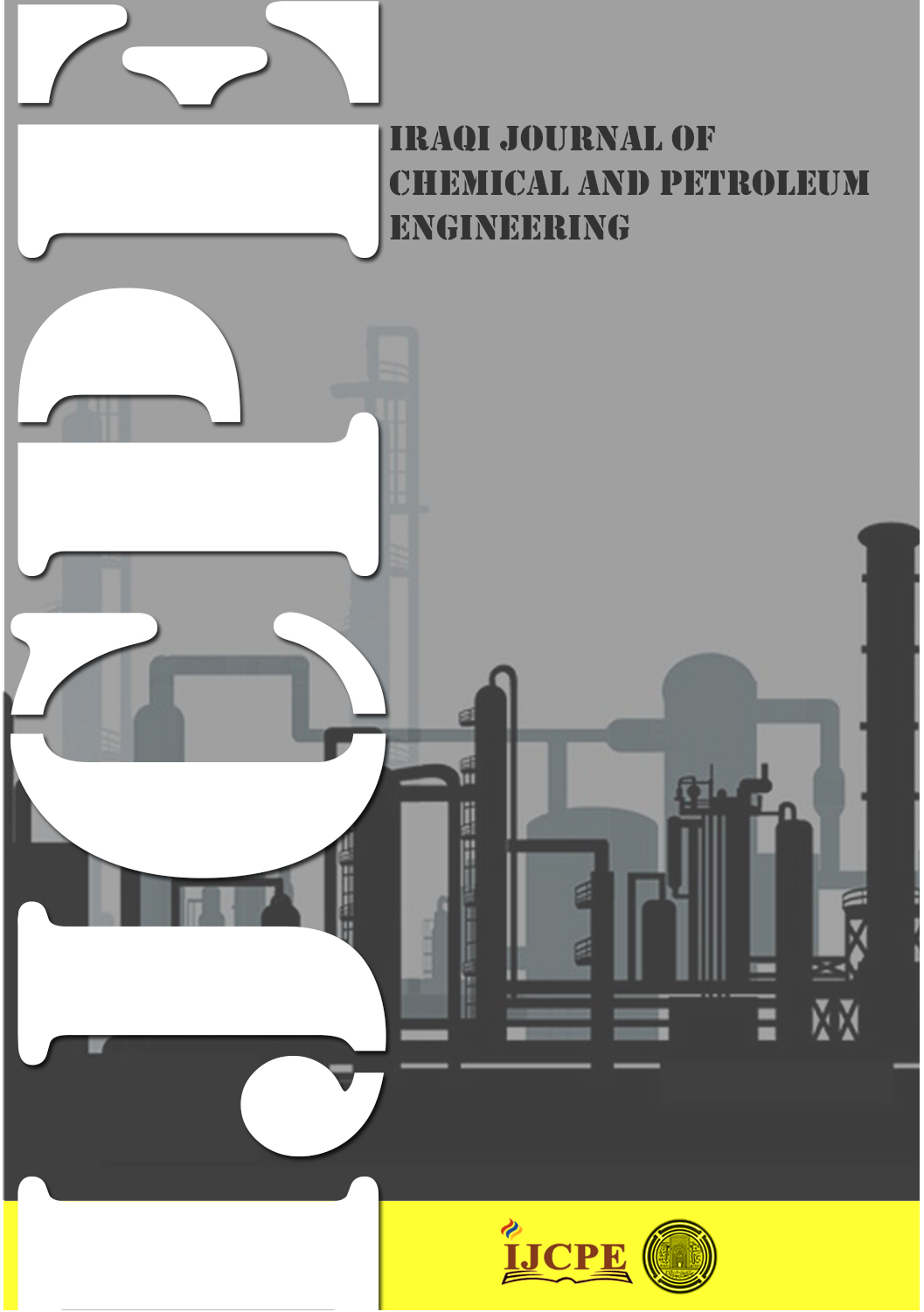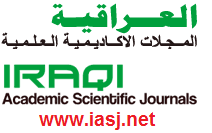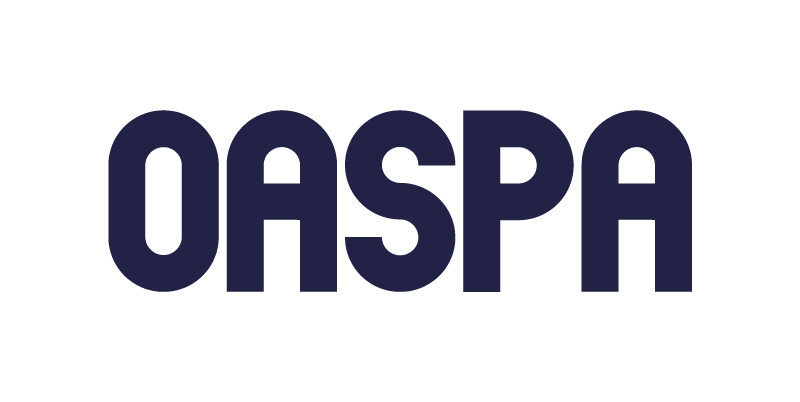Evaluation of microfiltration and ultrafiltration membranes for improving water quality: removal of turbidity, suspended solids, and bacteria from the Tigris River
DOI:
https://doi.org/10.31699/IJCPE.2025.1.3Keywords:
Microfiltration; Ultrafiltration; Tigris River; Hermia model; Membrane foulingAbstract
The Tigris River in Baghdad is increasingly polluted by industrial and agricultural activities and untreated sewage, posing serious risks to public health and the environment. This pollution degrades water quality through various physical, chemical, and biological contaminants. This research aims to use membrane filtration techniques to treat Tigris River water, improving water quality and ensuring a clean, safe water supply. The study assesses the efficiency of polypropylene (P.P) 1µm, ceramic 0.5µm microfiltration, and polyvinylidene fluoride (PVDF) 500KD ultrafiltration membranes in removing turbidity, total suspended solids (TSS), and E. coli, and their impact on permeate flux. Experiments were conducted at a temperature of 25°C and a flow rate of 20 L/h, with regular intervals and an initial turbidity of 65 NTU. The results indicated that after 1.25 hours of operations, the permeate flux decreased by 23.12% for polypropylene membranes, 32.63% for ceramic membranes, and 38.48% for PVDF membranes. The PVDF membrane demonstrated the best performance, removing 98.7% of turbidity, 88% of total suspended solids (TSS), and 100% of E. coli. This makes it the most efficient membrane among the tested options. Hermia’s model was used to study fouling in crossflow ultrafiltration (UF) and microfiltration (MF) membranes. Results showed that cake formation and standard pore-blocking models best predicted flux behavior for the ceramic membrane, while complete and intermediate pore-blocking models were more effective for the PVDF membrane. This study shows that membrane filtration improves Tigris River water quality by removing turbidity, suspended solids, and bacteria, ensuring a safe water supply.
Received on 21/10/2024
Received in Revised Form on 30/11/2024
Accepted on 30/11/2024
Published on 30/03/2025
References
[1] P. K. Singh et al., “Critical review on toxic contaminants in surface water ecosystem: sources, monitoring, and its impact on human health,” Environmental Science and Pollution Research., pp. 1–35, 2024. https://doi.org/10.1007/s11356-024-34932-0
[2] S. Giri, “Water quality perspective in Twenty First Century: Status of water quality in major river basins, contemporary strategies and impediments: A review,” Applied Sciences., vol. 271, p. 116332, 2021. https://doi.org/10.3390/app11093743
[3] N. Rahmanian et al., “Analysis of physiochemical parameters to evaluate the drinking water quality in the State of Perak, Malaysia,” Jornal of. Chemistry., vol. 2015, no. 1, p. 716125, 2015. https://doi.org/10.1155/2015/716125
[4] F. C. Bull et al., “World Health Organization 2020 guidelines on physical activity and sedentary behaviour,” British Journal of sports medicine., vol. 54, no. 24, pp. 1451–1462, 2020, https://doi.org/10.1136/bjsports-2020-102955
[5] L. Kumar, R. Kumari, A. Kumar, I. A. Tunio, and C. Sassanelli, “Water quality assessment and monitoring in Pakistan: A comprehensive review,” Sustainability, vol. 15, no. 7, p. 6246, 2023, https://doi.org/10.3390/su15076246
[6] N. Al-Ansari, N. Adamo, V. Sissakian, S. Knutsson, and J. Laue, “Water resources of the Tigris River catchment,” Journal of Earth Sciences and Geotechnical Engineering., vol. 8, no. 3, pp. 21–42, 2018.
[7] D. V Chapman, Water quality assessments: a guide to the use of biota, sediments and water in environmental monitoring. CRC Press, 2021, https://doi.org/10.1201/9781003062103
[8] G. Basílico, L. de Cabo, and A. Faggi, “Phytoremediation of water and wastewater: on-site and full-scale applications,” Phytoremediation: Management of Environmental Contaminants, Volume 2. Vol. 2, pp. 51–60, 2015. https://doi.org/10.1007/978-3-319-10969-5_5
[9] J. Hoslett et al., “Surface water filtration using granular media and membranes: A review,” Science of the Total Environment, 639, pp. 1268–1282, 2018, https://doi.org/10.1016/j.scitotenv.2018.05.247
[10] A. Bardhan, A. Akhtar, and S. Subbiah, “Microfiltration and ultrafiltration membrane technologies,” in Advancement in Polymer-Based Membranes for Water Remediation, Elsevier, 2022, pp. 3–42, https://doi.org/10.1016/B978-0-323-88514-0.00001-2
[11] E. Nascimben Santos, Z. László, C. Hodúr, G. Arthanareeswaran, and G. Veréb, “Photocatalytic membrane filtration and its advantages over conventional approaches in the treatment of oily wastewater: Asia‐Pacific Journal of Chemical Engineering., vol. 15, no. 5, p. e2533, 2020, https://doi.org/10.1002/apj.2533
[12] E. Obotey Ezugbe and S. Rathilal, “Membrane technologies in wastewater treatment: a review,” Membranes (Basel)., vol. 10, no. 5, p. 89, 2020, https://doi.org/10.3390/membranes10050089
[13] M. Bodzek and K. Konieczny, “The use of ultrafiltration membranes made of various polymers in the treatment of oil-emulsion wastewaters,” Waste management., vol. 12, no. 1, pp. 75–84, 1992, https://doi.org/10.1016/0956-053X(92)90011-7
[14] S. P. Bera, M. Godhaniya, and C. Kothari, “Emerging and advanced membrane technology for wastewater treatment: A review,” Journal of Basic Microbiology., vol. 62, no. 3–4, pp. 245–259, 2022, https://doi.org/10.1002/jobm.202100259
[15] K. Elsaid, M. Kamil, E. T. Sayed, M. A. Abdelkareem, T. Wilberforce, and A. Olabi, “Environmental impact of desalination technologies: A review,” Science of the total environment., vol. 748, p. 141528, 2020, https://doi.org/10.1016/j.scitotenv.2020.141528
[16] V. Srivastava, S. K. Mishra, U. P. Singh, R. Kumar, L. Sexana, and R. Kumar, “Membranes, Membranes Phenomena and Applications-A Review,” IJRAR-International Journal of Research and Analytical Reviews (IJRAR)., vol. 9, no. 3, pp. 403–467, 2022.
[17] A. Nqombolo, A. Mpupa, R. M. Moutloali, and P. N. Nomngongo, “Wastewater treatment using membrane technology,” Wastewater and water quality., vol. 29, pp. 30–40, 2018.
[18] M. K. Purkait, M. K. Sinha, P. Mondal, and R. Singh, “Introduction to membranes,” in Interface science and technology, vol. 25, Elsevier, 2018, pp. 1–37, https://doi.org/10.1016/B978-0-12-813961-5.00001-2
[19] S. M. Samaei, S. Gato-Trinidad, and A. Altaee, “The application of pressure-driven ceramic membrane technology for the treatment of industrial wastewaters–A review,” Separation and Purification Technology., vol. 200, pp. 198–220, 2018, https://doi.org/10.1016/j.seppur.2018.02.041
[20] M. W. Hakami, A. Alkhudhiri, S. Al-Batty, M.-P. Zacharof, J. Maddy, and N. Hilal, “Ceramic microfiltration membranes in wastewater treatment: filtration behavior, fouling and prevention,” Membranes (Basel)., vol. 10, no. 9, p. 248, 2020, https://doi.org/10.3390/membranes10090248
[21] H. Xiang, X. Min, C.-J. Tang, M. Sillanpää, and F. Zhao, “Recent advances in membrane filtration for heavy metal removal from wastewater: A mini review,” Journal of Water Process Engineering., vol. 49, p. 103023, 2022, https://doi.org/10.1016/j.jwpe.2022.103023
[22] K. Castro and R. Abejón, “Removal of Heavy Metals from Wastewaters and Other Aqueous Streams by Pressure-Driven Membrane Technologies: An Outlook on Reverse Osmosis, Nanofiltration, Ultrafiltration and Microfiltration Potential from a Bibliometric Analysis,” Membranes (Basel)., vol. 14, no. 8, p. 180, 2024, https://doi.org/10.3390/membranes14080180
[23] C. Yin-ru, L. Yu-jen, and L. Duu-jong, “Membrane fouling during water or wastewater treatments: Current research updated,” Journal of the Taiwan Institute of Chemical Engineers, vol. 0, pp. 1–9, 2019, https://doi.org/10.1016/j.jtice.2017.12.019
[24] M. H. Salih, A. F. Al-Alawy, "A novel forward osmosis for treatment of high-salinity East Baghdad oilfield produced water as a part of a zero liquid discharge system", Desalination and Water Treatment, Vol. 248, pp. 18-27, 2022, https://doi.org/10.5004/dwt.2022.28070
[25] F. Ahmed, B. S. Lalia, V. Kochkodan, N. Hilal, and R. Hashaikeh, “Electrically conductive polymeric membranes for fouling prevention and detection: A review,” Desalination, vol. 391, pp. 1–15, 2016, https://doi.org/10.1016/j.desal.2016.01.030
[26] M. Al-Shaeli, S. J. D. Smith, E. Shamsaei, H. Wang, K. Zhang, and B. P. Ladewig, “Highly fouling-resistant brominated poly (phenylene oxide) membranes using surface grafted diethylenetriamine,” RSC advances., vol. 7, no. 59, pp. 37324–37330, 2017, https://doi.org/10.1039/C7RA05524B
[27] S. Laohaprapanon, A. D. Vanderlipe, B. T. Doma Jr, and S.-J. You, “Self-cleaning and antifouling properties of plasma-grafted poly (vinylidene fluoride) membrane coated with ZnO for water treatment,” Journal of the Taiwan Institute of Chemical Engineers., vol. 70, pp. 15–22, 2017, https://doi.org/10.1016/j.jtice.2016.10.019
[28] P. C. Y. Wong, Y.-N. Kwon, and C. S. Criddle, “Use of atomic force microscopy and fractal geometry to characterize the roughness of nano-, micro-, and ultrafiltration membranes,” Journal of Membrane Science., vol. 340, no. 1–2, pp. 117–132, 2009, https://doi.org/10.1016/j.memsci.2009.05.018
[29] H. Xu et al., “Outlining the roles of membrane-foulant and foulant-foulant interactions in organic fouling during microfiltration and ultrafiltration: A mini-review,” Frontiers in chemistry, vol. 8, p. 417, 2020, https://doi.org/10.3389/fchem.2020.00417
[30] I. A. Khan, Y.-S. Lee, and J.-O. Kim, “A comparison of variations in blocking mechanisms of membrane-fouling models for estimating flux during water treatment,” Chemosphere, vol. 259, p. 127328, 2020, https://doi.org/10.1016/j.chemosphere.2020.127328
[31] S. Hube, J. Wang, L. N. Sim, T. H. Chong, and B. Wu, “Direct membrane filtration of municipal wastewater: Linking periodical physical cleaning with fouling mechanisms,” Separation and Purification Technology., vol. 259, p. 118125, 2021, https://doi.org/10.1016/j.seppur.2020.118125
[32] H. Choi, K. Zhang, D. D. Dionysiou, D. B. Oerther, and G. A. Sorial, “Effect of permeate flux and tangential flow on membrane fouling for wastewater treatment,” Separation and Purification Technology., vol. 45, no. 1, pp. 68–78, 2005, https://doi.org/10.1016/j.seppur.2005.02.010
[33] R. Bai and H. F. Leow, “Modeling and experimental study of microfiltration using a composite module,” Journal of membrane science., vol. 204, no. 1–2, pp. 359–377, 2002, https://doi.org/10.1016/S0376-7388(02)00063-7
[34] C.-W. Jung, H.-J. Son, and L.-S. Kang, “Effects of membrane material and pretreatment coagulation on membrane fouling: fouling mechanism and NOM removal,” Desalination, vol. 197, no. 1–3, pp. 154–164, 2006, https://doi.org/10.1016/j.desal.2005.12.022
[35] B. K. Nandi, A. Moparthi, R. Uppaluri, and M. K. Purkait, “Treatment of oily wastewater using low cost ceramic membrane: Comparative assessment of pore blocking and artificial neural network models,” Chemical Engineering Research and Design., vol. 88, no. 7, pp. 881–892, 2010, https://doi.org/10.1016/j.cherd.2009.12.005
[36] K. Konieczny and J. Rafa, “Modeling of the membrane filtration process of natural waters,” Polish Journal of Environmental Studies., vol. 9, no. 1, pp. 57–64, 2000.
[37] A. Gul, J. Hruza, and F. Yalcinkaya, “Fouling and Chemical Cleaning of Microfiltration Membranes: A Mini-Review". Polymers 2021, 13, 846, https://doi.org/10.3390/polym13060846
[38] M. H. Salih, A. M. Al-Yaqoobi, H. A. Hassan, and A. F. Al-Alawy, “Assessment of the Pressure Driven Membrane for the Potential Removal of Aniline from Wastewater.,” Jornal of Ecological Engineering., vol. 24, no. 8, 2023. https://doi.org/10.12911/22998993/166283
[39] G. A. AL-Dulaimi and M. K. Younes, “Assessment of potable water quality in Baghdad City, Iraq,” Air, Soil and Water Research., vol. 10, p. 1178622117733441, 2017, https://doi.org/10.1177/1178622117733441
[40] P. Mac Berthouex and L. C. Brown, [45] M. K. Mensoor, “Monitoring Pollution of the Tigris River in Baghdad by Studying Physico-Chemical Characteristics,” 2021. CRC Press, 2017, https://doi.org/10.21203/rs.3.rs-1074093/v1
[41] J. S. Al Hassany and H. E. Al Bayaty, “Screening of epiphytic algae on the aquatic plant Phragmites australis inhabiting Tigris river in Al-Jadria site, Baghdad, Iraq,” Baghdad science journal., vol. 14, no. 1, p. 85, 2017, http://dx.doi.org/10.21123/bsj.2017.14.1.0085
[42] J. A. Ghafil, H. K. Zghair, and A. K. Zgair, “Chemical and microbiological properties of drinking water in the city of Baghdad,” Diyala Journal of Medicine, 2022. https://doi.org/10.26505/djm.v23i1.924
[43] F. Edition, “Guidelines for drinking-water quality,” WHO chronicle., vol. 38, no. 4, pp. 104–108, 2011.
[44] T. Poerio et al., “Identification of fouling mechanisms in cross-flow microfiltration of olive-mills wastewater,” Journal of Water Process Engineering., vol. 49, p. 103058, 2022, https://doi.org/10.1016/j.jwpe.2022.103058
[45] S. A. Sadek, S. M. Al-Jubouri, and S. Al-Batty, “Investigating the Fouling Models of the Microfiltration Mixed Matrix Membranes-Based Oxide Nanoparticles Applied for Oil-in-Water Emulsion Separation,” Iraqi Journal of Chemical and Petroleum Engineering., vol. 25, no. 2, pp. 1–16, 2024. https://doi.org/10.31699/IJCPE.2024.2.1
[46] W. Zhang, W. Liang, G. Huang, J. Wei, L. Ding, and M. Y. Jaffrin, “Studies of membrane fouling mechanisms involved in the micellar-enhanced ultrafiltration using blocking models,” RSC Advances., vol. 5, no. 60, pp. 48484–48491, 2015, https://doi.org/10.1039/C5RA06063J
[47] E. M. Garcia-Castello, A. D. Rodriguez-Lopez, S. Barredo-Damas, A. Iborra-Clar, J. Pascual-Garrido, and M. I. Iborra-Clar, “Fabrication and performance of low-fouling UF membranes for the treatment of isolated soy protein solutions,” Sustainability, vol. 13, no. 24, p. 13682, 2021, https://doi.org/10.3390/su132413682
Downloads
Published
Issue
Section
License
Copyright (c) 2025 The Author(s). Published by College of Engineering, University of Baghdad.

This work is licensed under a Creative Commons Attribution 4.0 International License.













